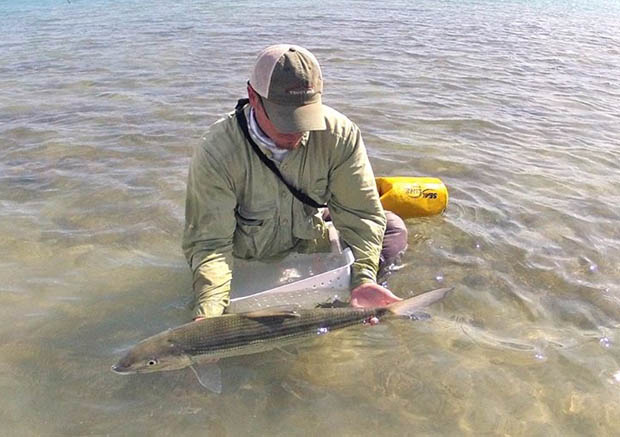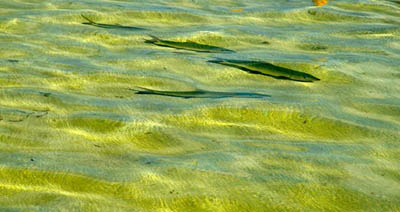How best to enjoy a bonefishing trip to the Bahamas
[dropcap]A[/dropcap]fly fishing destination beyond home waters is not, nor has it ever been, cheap. To maximize your enjoyment, reward your expenditure and catch fish always arrive in the Bahamas well practiced.
If you can’t cast from the ready position off the deck of a flats boat in a 15-knot wind, do so in one or two false casts, and lead a tailing bonefish moving your way – your bonefishing trip to the Bahamas will be an unsatisfying $4,000 sun tanning experience.
What does that mean? it means you’re not going to catch more than a cold if you can’t double haul, or hit a target at 40-feet. It means you’re going to take too many false casts to reach the target and then, in the wind, watch the entire leader collapse a few feet in front of the fly line; not anywhere near enticing that tailing bonefish into an eat.
You MUST practice for any bonefishing outing, even if you consider yourself good to go
And it’s fun if you have a goal. If you’re green, call a nearby fly shop or a look up a Federation of Fly Fishers Certified Casting Instructor near you and sign-up for a series of lessons. Your goal is to cast from the ready position (fly in the off hand) with about two rod lengths of fly line out (probably the hardest thing for a beginner to learn). Be able to cast the fly, utilizing the double haul, and in one or two false casts hit your target at 40- to 45-feet and, preferably, longer.
In the recipe of success, an essential ingredient is the double haul
The double haul is counter-intuitive so it won’t be three tries and you got it. And because you’re a good golfer, spin fisher won’t aid you, you can’t borrow from those skills. The double haul is an all alone, nothing like it skill.
Don’t practice picking up 30- or 40-feet of fly directly in-front of you, come game time and you’ll not score. Instead practice casting to that pretend fish from the ready position. That’s your real-time need.
Hit the target
A good angler can make a cast in a few seconds, and hit targets at varied distances. If you practice hitting the same target over and over, you do a disservice to your time and effort. Pick out several targets a varied distances and let the wind play in the game. You’ll improve faster. Getting the fly out quickly and on target will make for a happy day on the water.
May the wind be always at your back
It’s important to be able to cast into a headwind, but the most difficult cast is when the wind is blowing at your casting shoulder. Hint: Take the backcast back low and away, and forward cast high above you head. Get the feel of that before trying in a real wind condition. Again, practice casting in all directions and distances. BTW, with wind at your casting shoulder, getting whacked in the head with a lead-eye gotcha will earn more than an “ouch” response.
Strip strike for solid hook-ups and shorter battles
Put the rod between your legs and strip line in hand over hand. Strip striking will give you better fly movement, control and produce a firm gotcha’ hook set.
The one thing that trips anglers up all too often is too many false casts
Fish wait for no man. A single false cast producing a shadow the rides a fish will spook it. Add multiple false casts to your presentation and that fish will have moved on. With almost all fish, and especially bonefish, the window of opportunity is measured in a few seconds. Multiple false casts will almost always assure failure.
Your practice should have a goal of no more than two false casts. One is, of course, better.
[information]
NOTES
1. The better guides ask to see you cast before leaving the dock, then ask you how far that cast was. One, it establishes what you’re capable of with regard to fly casting and, two, the guide now knows what you think X-feet is. He or she will use both of the latter as measuring sticks.
2. Don’t strip line off the reel into the boat. You’ll be picking up line from the bottom of the pile first and a tangle will ensue. Cast out the line, then retrieve it back into the boat. Now your pulling line out properly.
3. A bonefish guide, or any flats guide, will use the clock to indicate where the target is. For example, the guide will say 11-o’clock at 50-feet and moving left. The bow is 12-o’clock.
4. Fish barefooted, flats animals, like bonefish don’t like unnatural noises. When bare footed you can feel line should it be under foot.
5. Pay attention to your guide, he does what he’s doing for you everyday.
[/information]









